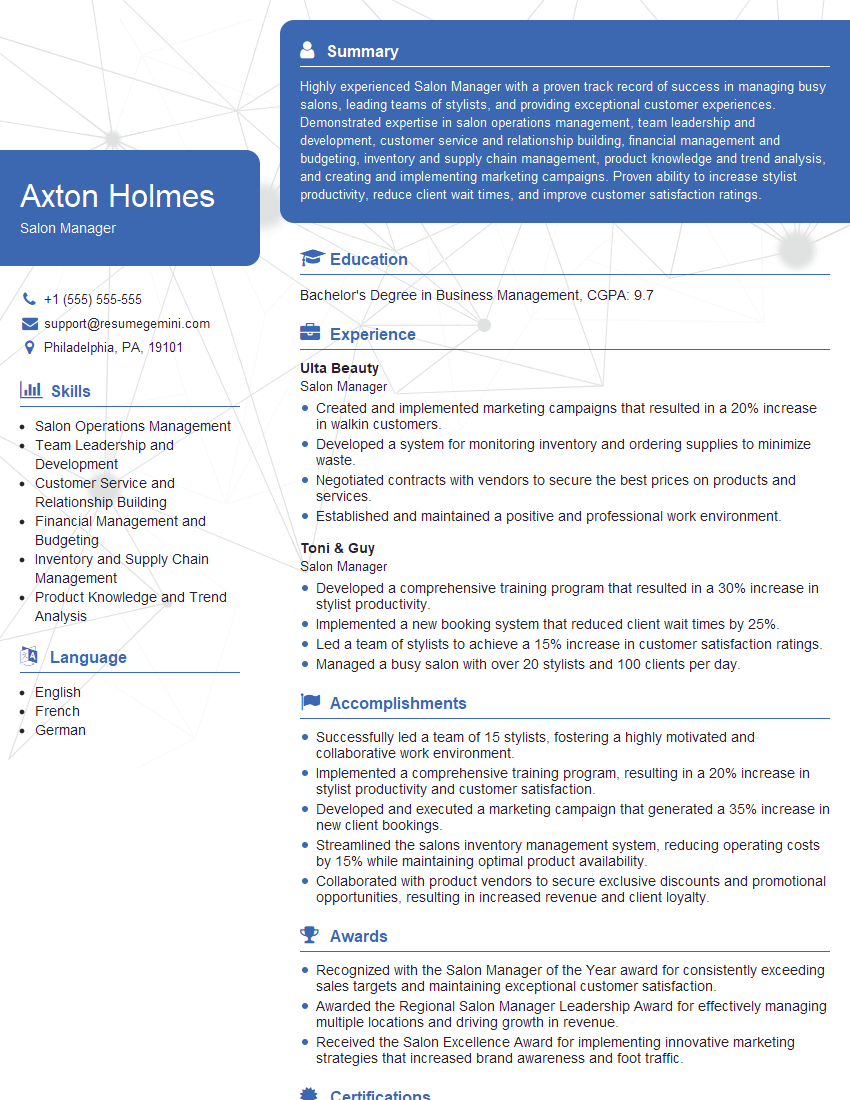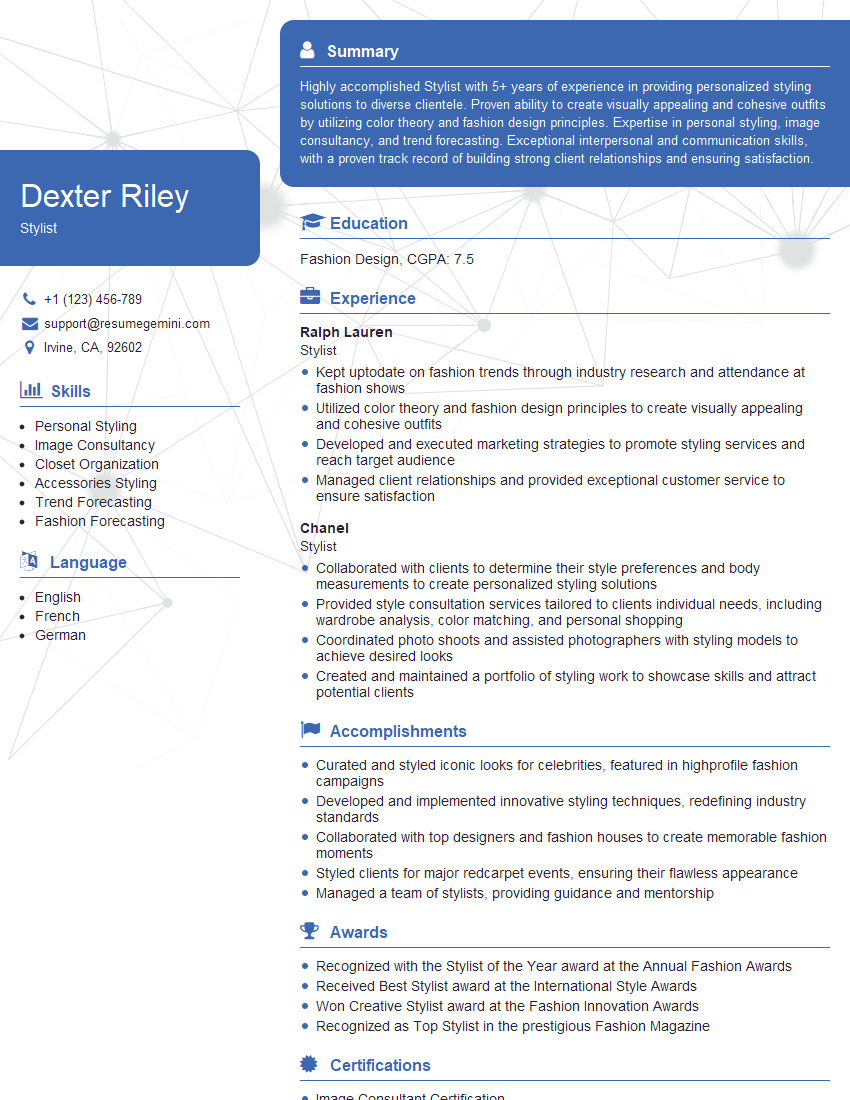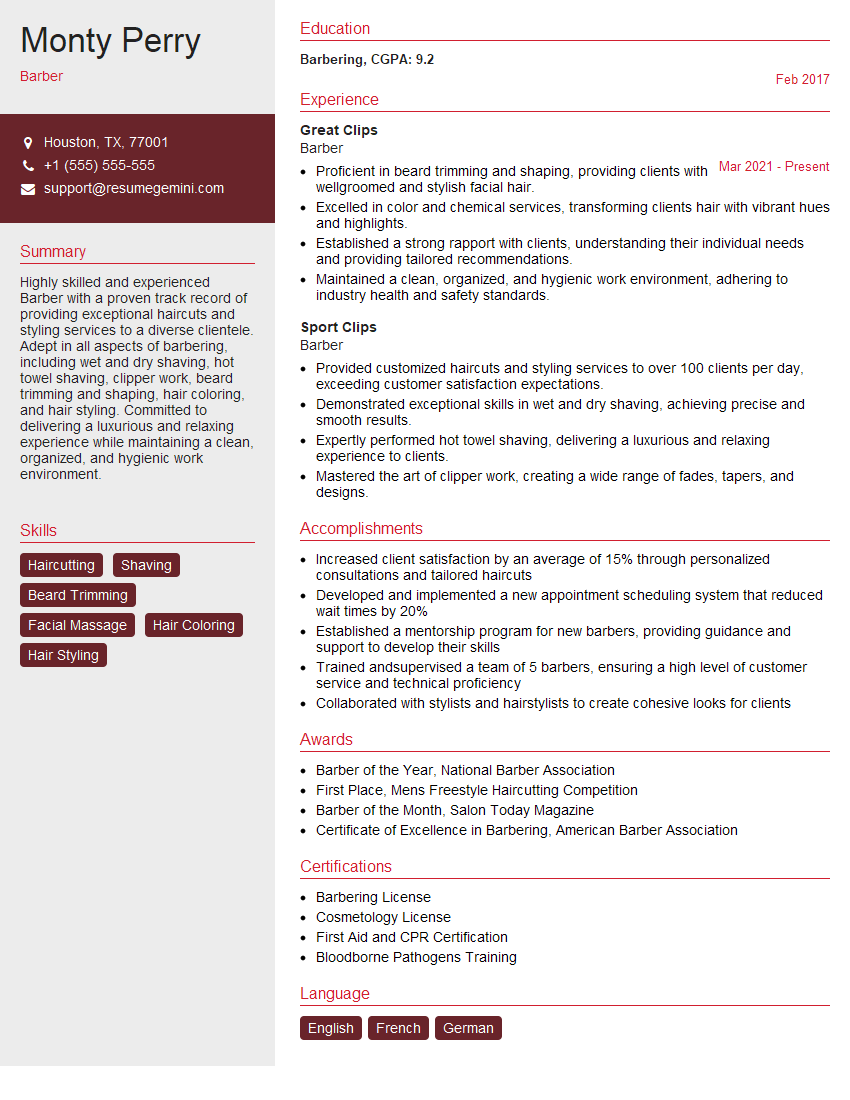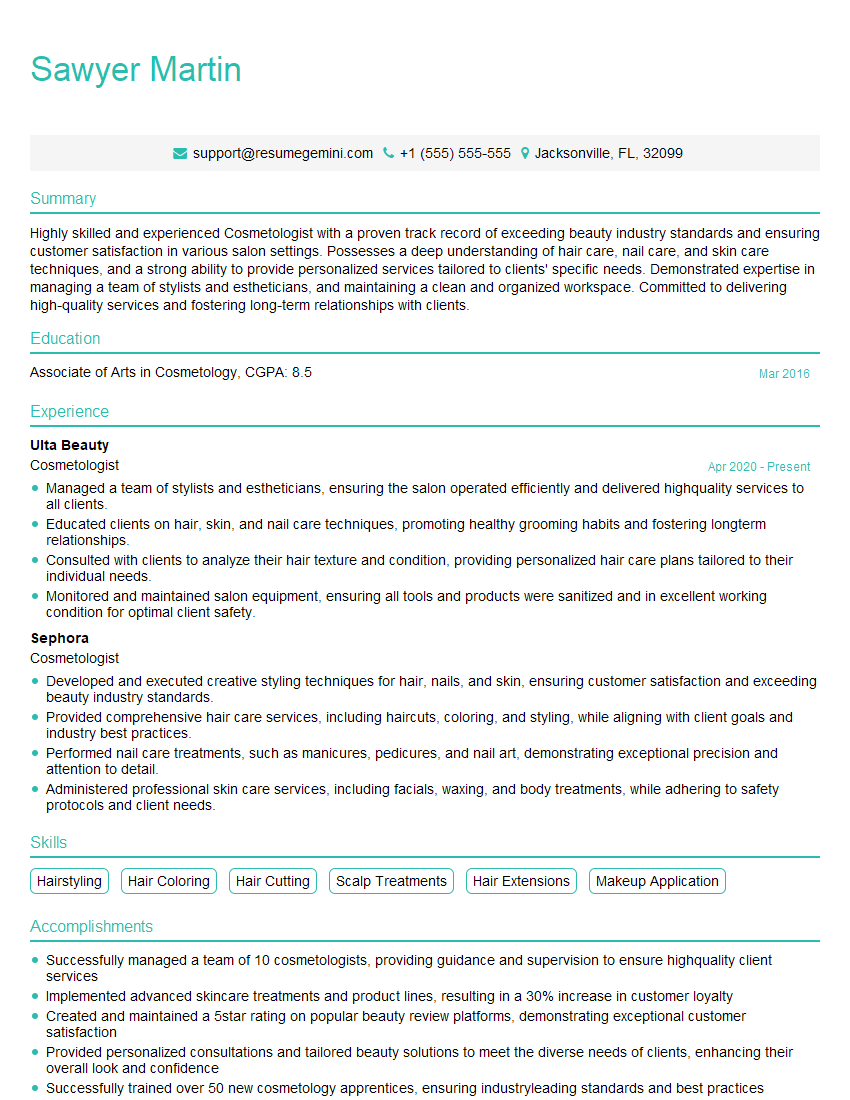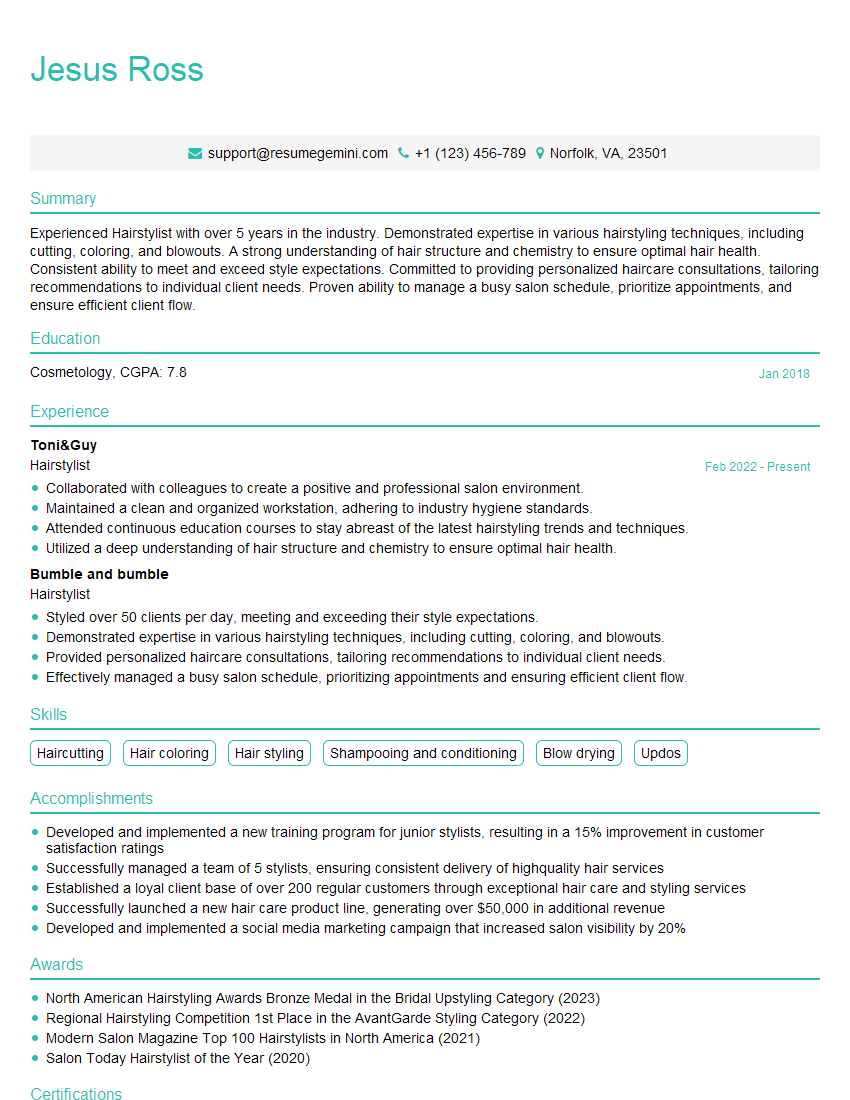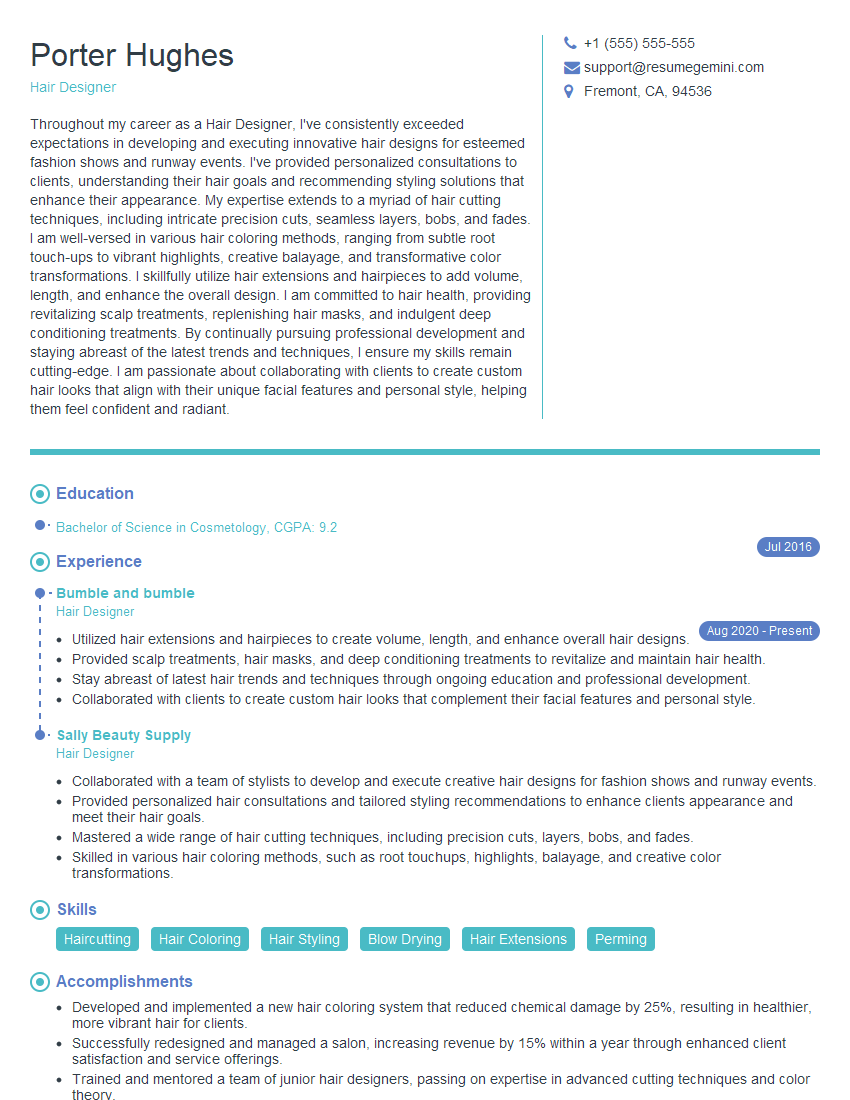Interviews are opportunities to demonstrate your expertise, and this guide is here to help you shine. Explore the essential Hairstyling interview questions that employers frequently ask, paired with strategies for crafting responses that set you apart from the competition.
Questions Asked in Hairstyling Interview
Q 1. Describe your experience with various hair cutting techniques.
My experience encompasses a wide range of hair cutting techniques, from classic to modern. I’m proficient in various cutting methods tailored to different hair textures and styles.
- Point Cutting: This technique uses the tips of the shears to remove weight and create texture, ideal for adding movement to layered haircuts or softening blunt lines. For example, I often use point cutting on the ends of long layers to prevent them from looking heavy.
- Slide Cutting: This involves sliding the shears along the hair shaft to create soft, blended layers. It’s perfect for creating a seamless, graduated bob or adding subtle texture to long hair. I frequently use this technique when blending short layers into longer ones.
- Blunt Cutting: This is a precise method that creates clean, sharp lines. It’s a fantastic choice for creating a sleek, modern bob or adding a strong, defined shape to any style. I often use this for clients who desire a bold, geometric look.
- Texturizing: This involves using shears or razors to remove bulk and create texture. This is essential for adding volume to fine hair or creating a more dynamic style for thicker hair. I adapt this technique based on the specific needs of the client’s hair – for example, I might use a razor for a more aggressive texture in thick, coarse hair, whereas I’d use thinning shears for a softer effect on finer hair.
My expertise allows me to select the most appropriate technique based on the client’s hair type, desired style, and overall face shape, ensuring a personalized and flattering result.
Q 2. Explain your process for assessing a client’s hair type and needs.
Assessing a client’s hair is a crucial first step. I begin with a thorough consultation, visually inspecting the hair and asking detailed questions. My process involves:
- Visual Inspection: Observing the hair’s length, texture (fine, medium, thick, coarse), density (number of hairs per square inch), porosity (how well it absorbs moisture), and elasticity (how well it stretches and returns to its original shape).
- Hair History: Understanding past treatments (color, chemical processing), previous styling practices, and any potential damage or concerns.
- Client Consultation: Discussing their desired style, lifestyle (how much time they’re willing to spend styling), and any preferences or limitations (e.g., allergies to certain products).
- Touch Test: Actually feeling the texture of the hair to determine its coarseness and potential dryness or oiliness. This helps me choose appropriate products and techniques.
For example, a client with fine, limp hair will require different styling and cutting techniques compared to a client with thick, coarse hair. Understanding these differences is critical to achieving the desired outcome. Based on my assessment, I create a customized plan to address their needs and achieve their desired look.
Q 3. How do you handle difficult clients or challenging hair situations?
Handling difficult clients or challenging hair situations requires patience, empathy, and strong communication skills. My approach focuses on:
- Active Listening: Patiently hearing out their concerns and addressing them directly and honestly. Sometimes, clients are unhappy due to miscommunication about the desired style.
- Clear Communication: Explaining the technical aspects of hair in simple, understandable terms. I use visual aids like photos or style books to bridge the communication gap.
- Finding Common Ground: Collaborating with the client to find a style that meets their expectations and is achievable given their hair type and condition. Sometimes, we need to compromise to arrive at a satisfactory solution.
- Problem-Solving: If a styling or coloring process doesn’t go as planned, I analyze the situation, address the issue professionally, and make every effort to rectify the situation. This might involve a re-do or alternative solutions.
For instance, if a client is unhappy with a haircut, I’ll offer suggestions for styling to minimize the perceived problem and, if necessary, adjust the cut further to better suit their preferences. Maintaining a calm and professional demeanor throughout the process is key to diffusing tension and achieving a positive outcome.
Q 4. What are your go-to styling products and why?
My go-to styling products are chosen based on their versatility and effectiveness for various hair types.
- High-quality Shampoo and Conditioner: These form the foundation of healthy hair. I often recommend products tailored to specific hair needs (e.g., moisturizing for dry hair, volumizing for fine hair).
- Leave-in Conditioner or Serum: These help to detangle and add shine, protecting the hair from heat styling. I select serums based on hair texture and thickness.
- Volumizing Mousse or Root Lift Spray: For clients wanting more body, these products add volume without weighing the hair down.
- Heat Protectant Spray: Essential to protect hair from damage caused by heat styling tools (straighteners, curling irons).
- Hairspray: A lightweight hairspray provides hold without stiffness. I choose the level of hold depending on the hairstyle’s needs.
The specific product brands and types vary depending on the client’s hair type and styling needs. For example, I might recommend a lightweight mousse for fine hair, while a stronger hold gel might be more suitable for thick, coarse hair.
Q 5. Describe your experience with different hair coloring techniques (balayage, ombre, highlights).
I have extensive experience with various hair coloring techniques.
- Balayage: This is a freehand painting technique that creates a natural-looking, sun-kissed effect. It involves strategically placing highlights throughout the hair, resulting in a soft, blended look. I customize the placement of highlights to complement the client’s face shape and skin tone.
- Ombre: This technique involves a gradual transition of color from dark roots to lighter ends. It creates a stylish and often dramatic look that’s low-maintenance as the roots grow out. I pay close attention to the transition, making sure it’s smooth and natural.
- Highlights: This involves lightening specific strands of hair to add dimension and brightness. I can achieve various highlight effects using foils, caps, or freehand techniques, adapting the technique to the client’s preferences and hair type. For example, fine highlights are ideal for adding subtle dimension to light brown hair, whereas thicker highlights can create a bolder look.
Safety and proper application are always paramount. I always conduct a strand test before any full coloring application to ensure compatibility and predict the results.
Q 6. How do you maintain hygiene and sanitation standards in your work?
Maintaining hygiene and sanitation is crucial in the hairdressing profession. My practices include:
- Disinfection of Tools: All tools (scissors, combs, brushes, clippers) are thoroughly disinfected with a hospital-grade disinfectant after each client. I follow manufacturer’s instructions carefully.
- Clean Work Station: My work station is cleaned and sanitized before and after every client, including the removal of hair and debris.
- Clean Towels and Capes: Clean, disposable towels and capes are used for every client.
- Hand Hygiene: I wash my hands thoroughly before and after each client, using antibacterial soap.
- Gloves: I wear disposable gloves when handling chemicals (hair color, perms). These are disposed of properly after use.
These practices ensure a safe and hygienic environment for my clients and myself, minimizing the risk of infections and allergic reactions. Adhering to these protocols is not just a matter of professional etiquette, but a vital part of protecting my clients’ health.
Q 7. What are your skills in updos and special occasion hairstyles?
I possess a wide array of skills in creating updos and special occasion hairstyles. My repertoire includes:
- Classic Chignons and Buns: From elegant low buns to high, structured chignons, I adapt these styles to suit the client’s face shape, dress, and overall preference.
- Braided Updos: I can incorporate various braiding techniques (French braids, fishtail braids, Dutch braids) into intricate updos for a unique and textured look.
- Romantic Updos: These styles often feature loose curls and soft waves pinned up in a way that looks effortless yet sophisticated.
- Modern Updos: These can range from sleek, geometric shapes to more textured, deconstructed styles. I tailor these styles to modern trends and client preferences.
- Bridal and Special Occasion Styles: I’ve extensive experience creating intricate and unique hairstyles for weddings and other special events, working closely with the client to envision and create the perfect look. This includes working with veils, headpieces, and other accessories.
I pride myself on creating hairstyles that not only look stunning but also feel comfortable and secure throughout the event. I ensure that every style is tailored to the individual, considering their hair type, length, and personal style to create a flawless look for their special occasion.
Q 8. How do you stay updated with current hair trends and techniques?
Staying current in the dynamic world of hairstyling requires a multi-pronged approach. I dedicate time each week to actively seeking out new trends and techniques. This involves several key strategies:
- Industry Publications & Websites: I regularly read magazines like American Salon, Modern Salon, and Behind the Chair, and follow influential stylists and brands on social media platforms like Instagram and TikTok. These platforms offer a constant stream of visual inspiration and educational content.
- Educational Workshops & Seminars: I actively participate in advanced training courses and workshops hosted by leading hair product companies and renowned hairstylists. These events provide hands-on experience with the latest tools and techniques, allowing me to refine my skills and learn about new product innovations.
- Hair Shows & Trade Events: Attending hair shows, like the ones at Cosmoprof, provides exposure to the latest trends and innovations directly from industry leaders. It’s a fantastic opportunity to network with other professionals and gain insights into emerging styles.
- Continuing Education: I’m committed to ongoing professional development. This includes completing online courses and certifications to stay informed about new developments in hair science, color theory, and styling techniques. This ensures I’m always expanding my knowledge base.
By combining these methods, I maintain a thorough understanding of the latest trends and ensure my skills remain sharp and relevant.
Q 9. Explain your experience with hair extensions (application, maintenance, removal).
I have extensive experience with various hair extension methods, including tape-in, sew-in, micro-rings, and fusion bonds. My process encompasses three key phases:
- Application: Before application, I thoroughly consult with the client to determine the best extension type and color match based on their hair type, length, and desired style. Careful sectioning and precise placement are crucial for a natural look. For example, with tape-in extensions, I apply small, even sections to avoid bunching and ensure a seamless blend. With sew-in extensions, I create a comfortable and secure braid pattern to minimize scalp tension.
- Maintenance: Proper maintenance is vital for the longevity and health of both the extensions and the natural hair. This includes regular brushing with a detangling brush, using sulfate-free shampoos and conditioners, and avoiding excessive heat styling. I advise clients on the appropriate products and techniques to ensure their extensions remain healthy and beautiful. For example, I recommend using a leave-in conditioner to prevent tangling and breakage.
- Removal: Extension removal requires specialized techniques to prevent damage to the natural hair. The method depends on the type of extension used. For tape-in extensions, a dissolving solution is used to safely remove the adhesive. Sew-in extensions require careful unraveling of the braid pattern. I always prioritize the health of the client’s natural hair during the removal process. A follow-up consultation is recommended to assess the hair’s condition and provide post-removal care recommendations.
Q 10. How do you manage your time effectively when working with multiple clients?
Effective time management is crucial in a busy salon environment. My approach involves a combination of meticulous planning and efficient execution. I utilize several strategies:
- Detailed Scheduling: I carefully schedule appointments, allotting sufficient time for each service based on complexity and client needs. This minimizes delays and ensures I remain on schedule throughout the day.
- Prioritization: I prioritize tasks to ensure the most time-sensitive services are addressed first. For example, if I have a client with a complex color correction and another with a simple trim, I’ll prioritize the more involved service.
- Efficient Workflow: I’ve developed an efficient workflow to minimize time wasted between services. This includes pre-preparing tools and products, cleaning workspaces quickly, and utilizing time-saving techniques like quick-dry products.
- Communication: Open communication with clients about potential delays or changes in the schedule helps manage expectations. I always aim to be transparent and keep clients informed.
By consistently applying these strategies, I ensure smooth client flow and maximize productivity within my workday.
Q 11. Describe your knowledge of different hair textures and how you adapt your techniques accordingly.
Understanding different hair textures is fundamental to providing customized services. Hair texture varies greatly, influenced by factors like density, porosity, and elasticity. I adapt my techniques accordingly:
- Fine Hair: For clients with fine hair, I use lightweight products and gentle techniques to avoid weighing the hair down or causing breakage. I might suggest volumizing products and avoid heavy layering techniques.
- Thick Hair: With thick hair, I utilize techniques that help manage volume and create manageable shapes. This could include layering, texturizing, and the use of stronger hold products.
- Curly Hair: Curly hair requires specialized techniques to maintain definition and reduce frizz. I focus on using moisturizing products, detangling gently, and employing cutting techniques that enhance curl patterns.
- Coarse Hair: Coarse hair can be more resistant to styling products. I select products designed for coarse hair and employ techniques to soften and smooth the hair while maintaining its natural texture.
Assessing a client’s hair texture, understanding its unique properties, and adapting my techniques accordingly are crucial for achieving optimal results and maintaining the client’s hair health.
Q 12. What is your approach to consulting with clients on their hair goals?
My approach to client consultations is collaborative and comprehensive. I begin by actively listening to the client’s desires and aspirations for their hair. This involves:
- Understanding their goals: I ask open-ended questions to understand their lifestyle, preferences, and what they hope to achieve with their hair. This might involve photos of hairstyles they like or a discussion of their daily hair care routine.
- Assessing their hair: I thoroughly assess their current hair condition, including texture, length, density, and any damage or concerns. This assessment informs my recommendations.
- Providing realistic expectations: I provide honest and realistic feedback, explaining the feasibility of their goals given their hair type and condition. I also discuss potential challenges and solutions.
- Creating a plan: Together, we develop a personalized plan that outlines the steps needed to achieve their desired look, including specific products and maintenance recommendations.
This approach ensures the client feels heard and understood, fostering trust and leading to more satisfying outcomes.
Q 13. How do you handle client feedback, both positive and negative?
Client feedback, both positive and negative, is invaluable for continuous improvement. I handle feedback with professionalism and grace:
- Positive Feedback: I express gratitude for positive feedback and use it to reinforce what I’m doing well. It boosts my confidence and motivates me to continue providing excellent service.
- Negative Feedback: I listen carefully to negative feedback without becoming defensive. I try to understand the client’s perspective and address their concerns. If a mistake was made, I apologize sincerely and offer a solution, such as a complimentary service or a product recommendation to rectify the situation. I also use this feedback as an opportunity to identify areas for improvement in my technique or communication.
I view all feedback as an opportunity to learn and grow as a hairstylist. This approach ensures I maintain high standards of professionalism and client satisfaction.
Q 14. What are your strengths and weaknesses as a hairstylist?
My strengths lie in my creative vision, technical skills, and client communication abilities. I’m adept at creating custom looks that suit individual client needs and preferences. I also possess a strong understanding of hair science and various techniques, allowing me to tackle even complex styling challenges. My ability to connect with clients and build rapport makes the overall salon experience positive and enjoyable.
One area where I am continually striving for improvement is time management, particularly when dealing with unexpected complications during a service. While I have efficient systems in place, unexpected factors, like particularly challenging hair to work with, can sometimes lead to minor time overruns. To address this, I’m focusing on optimizing my workflow and continuing to refine my techniques to enhance speed and efficiency.
Q 15. What are your salary expectations?
My salary expectations are in line with my experience and skillset, and the industry standards for a senior hairstylist with my qualifications. I am open to discussing a competitive compensation package that reflects my contributions to the salon’s success. I’m confident that my expertise in various hair treatments and styling techniques will generate a significant return on investment for the salon.
Career Expert Tips:
- Ace those interviews! Prepare effectively by reviewing the Top 50 Most Common Interview Questions on ResumeGemini.
- Navigate your job search with confidence! Explore a wide range of Career Tips on ResumeGemini. Learn about common challenges and recommendations to overcome them.
- Craft the perfect resume! Master the Art of Resume Writing with ResumeGemini’s guide. Showcase your unique qualifications and achievements effectively.
- Don’t miss out on holiday savings! Build your dream resume with ResumeGemini’s ATS optimized templates.
Q 16. Describe your experience with chemical treatments (perms, relaxers).
I have extensive experience with chemical treatments like perms and relaxers. My expertise encompasses all aspects, from thorough client consultations to assessing hair health and selecting the appropriate products and techniques. For example, I can skillfully perform both traditional and modern perming techniques, adapting to different hair types and textures. With relaxers, I prioritize minimizing damage through careful application and the use of quality products and neutralizing solutions. I understand the crucial role of strand testing in both processes to avoid potential chemical damage or allergic reactions. I am also proficient in various relaxer types, including lye and no-lye relaxers, choosing the best option for each client’s specific hair needs.
My experience also includes managing potential complications such as breakage or chemical burns, and addressing them promptly and effectively with proper repair treatments. Safety and client satisfaction are paramount in my approach to these services.
Q 17. Explain your knowledge of hair health and scalp conditions.
A strong understanding of hair health and scalp conditions is fundamental to my work. I am well-versed in diagnosing common scalp issues like dandruff, psoriasis, and seborrheic dermatitis, recognizing their symptoms and suggesting appropriate treatments. For instance, I can recommend specialized shampoos and conditioners, lifestyle changes, and even suggest consulting a dermatologist when necessary. Beyond scalp conditions, I thoroughly assess the overall health of the hair itself, considering factors like porosity, elasticity, and damage levels. This comprehensive analysis informs my treatment recommendations and styling choices. For example, if a client has extremely porous hair (meaning the hair cuticle is raised, resulting in dryness and damage), I would adjust my approach, recommending deep conditioning treatments and avoiding harsh chemical processes.
Q 18. How do you deal with damaged hair and recommend appropriate treatments?
Dealing with damaged hair requires a multifaceted approach. My initial step involves a thorough consultation, carefully examining the hair to determine the extent and cause of the damage (heat styling, chemical treatments, environmental factors). I then create a personalized treatment plan that may include deep conditioning treatments, protein treatments, or even a combination of both, depending on the hair’s specific needs. For instance, if the damage is mainly due to heat styling, I may recommend a moisture-rich treatment to replenish lost hydration. If protein is lacking, I’ll incorporate a protein treatment to strengthen the hair shaft.
I also advise clients on preventative measures, emphasizing the importance of using heat protectants, avoiding excessive heat styling, and utilizing gentle hair care products. Regular trims are essential to remove split ends and prevent further damage. I always set realistic expectations with clients regarding the time it takes to repair damage, making sure they understand that patience and consistent care are key to achieving healthy, strong hair.
Q 19. Describe your experience with various hair styling tools (straighteners, curling irons, blow dryers).
I’m highly proficient in using various hair styling tools, and I understand their capabilities and limitations. This includes straighteners, curling irons, and blow dryers. My expertise extends beyond simply knowing how to operate these tools; I understand how different heat settings and techniques affect various hair types. For example, I know how to achieve a sleek, straight look with a flat iron on thick, coarse hair without causing damage by using lower heat settings and working in smaller sections. With curling irons, I can create a variety of curls and waves, from loose beach waves to tight ringlets, adjusting technique based on hair texture and desired style. I am also adept at using a blow dryer to create volume, smooth hair, and achieve various styles, understanding the impact of nozzle attachments and airflow. Safety is always a top priority; I regularly check the condition of my tools and ensure they are used correctly to avoid burns or damage to the client’s hair.
Q 20. What are your skills in creating different types of braids?
I have a broad repertoire of braiding skills, ranging from classic styles like French braids, Dutch braids, and fishtail braids to more intricate and contemporary designs. I can adapt my braiding techniques to different hair lengths, textures, and densities. For example, I can create a sophisticated French braid on fine hair by using a tighter tension to create a neat and structured look. Conversely, with thick, coarse hair, I might adjust the tension to avoid pulling or discomfort, ensuring a comfortable and stylish result. I regularly incorporate braiding into more complex updos and protective hairstyles, showcasing my creative versatility. I’m always expanding my knowledge of braiding styles through continuous learning and exploring new techniques.
Q 21. How do you handle difficult hair textures or situations (e.g., thick, coarse, fine hair)?
Handling difficult hair textures or situations requires adaptability and expertise. With thick, coarse hair, I focus on techniques that detangle efficiently and minimize breakage, often starting with pre-treatment oils or conditioners. Fine hair needs a gentler approach, using lighter products and avoiding harsh styling techniques that could lead to volume loss or damage. For clients with extremely curly or textured hair, I understand the importance of utilizing products designed to manage curl patterns and define curls without weighing them down. I also tailor my consultations to address individual concerns, offering solutions and realistic expectations based on hair type and desired outcome. A collaborative approach with my client ensures mutual understanding and a satisfying result.
Q 22. What is your experience with men’s hairstyling?
My experience with men’s hairstyling spans over eight years, encompassing a wide range of styles, from classic cuts like fades and pompadours to modern trends like textured crops and undercut variations. I’ve worked with diverse hair types and textures, mastering techniques for thick, thin, straight, curly, and coily hair. My expertise extends to various styling products and tools, enabling me to achieve desired looks and provide tailored advice on hair care routines for optimal results. I’m proficient in using clippers, shears, razors, and styling products to create clean lines, precise shapes, and finishes.
For instance, I recently styled a client with thick, wavy hair who wanted a low-maintenance yet stylish look. I created a textured crop with a fade on the sides, emphasizing his natural wave pattern with a texturizing product. This style suited his lifestyle and hair type perfectly.
Q 23. Describe your approach to creating a personalized style for each client.
My approach to creating personalized styles is highly collaborative. It starts with a thorough consultation, where I listen attentively to the client’s preferences, lifestyle, and hair goals. We discuss their face shape, hair texture, and daily routine. I analyze their existing hair condition and assess its potential. I show them examples of styles that might suit them, offering realistic expectations based on their hair type. Then, I use my expertise to suggest modifications or alternatives that enhance their features and complement their personality. I always consider how practical the style is for their daily life and recommend appropriate home care routines.
For example, a client might want a long, layered style, but if their hair is very fine, I might suggest adding layers to create volume instead of length, while still achieving the desired style.
Q 24. How do you manage your inventory of products and tools?
Managing my inventory involves a combination of careful ordering, regular stocktaking, and organized storage. I maintain a detailed inventory list, updated regularly after each order or use of products. I utilize a first-in, first-out (FIFO) system to minimize waste and ensure that products don’t expire. My tools are meticulously cleaned and sanitized after each use, and regularly sharpened and maintained to ensure optimal performance. I also keep a dedicated space for storage, maintaining a clear and organized arrangement to make finding specific tools and products easy and quick. This streamlined system reduces time wasted searching for supplies during a busy day and ensures I always have the right tools at hand.
Q 25. What is your experience with working in a team environment?
I thrive in team environments. In my previous salon, I collaborated closely with other stylists, sharing knowledge, and supporting each other. We assisted each other when needed, offering advice on tricky styles or techniques. We also regularly shared our product knowledge and assisted each other with managing the daily flow of clients. Effective teamwork is crucial in a salon; it not only increases productivity but also creates a positive and supportive working environment for everyone.
For instance, if a colleague was running behind schedule, I would offer to help with a simple task, ensuring that all clients received timely service. This collaborative approach fosters a supportive culture and enhances client experience.
Q 26. Describe a time you had to troubleshoot a challenging hair styling situation.
Once, a client came in with severely damaged hair from a previous home coloring attempt. Her hair was brittle, breaking easily, and uneven in color. My initial challenge was to assess the damage without causing further harm. I started by carefully analyzing her hair’s condition, identifying the areas of most significant damage. Instead of trying to fix it immediately, I focused on a deep conditioning treatment to restore moisture and strength. We discussed realistic expectations, choosing a style that minimized strain on her hair while improving its appearance. Over several sessions, we gradually improved her hair’s condition using protein treatments, color correction, and low-heat styling techniques.
This situation taught me the importance of patience, communication, and realistic expectations when dealing with challenging hair issues.
Q 27. How do you ensure client satisfaction and build rapport?
Ensuring client satisfaction and building rapport involves a holistic approach. It starts from the moment they walk in, with a warm welcome and attentive listening. Throughout the styling process, I maintain open communication, keeping them informed about each step. I actively seek their feedback, addressing any concerns or adjustments promptly. I make them feel comfortable and relaxed, creating a friendly atmosphere. Post-styling, I explain proper hair care practices, ensuring they can maintain their new look at home. Following up with a text or email shows that I value their patronage and am genuinely interested in their long-term hair health.
Building a connection goes beyond just the service; it’s about building trust and creating a positive experience that keeps clients returning.
Q 28. What are your career goals in hairstyling?
My career goals involve continuous growth and development in the hairstyling industry. I aim to expand my expertise in advanced cutting and coloring techniques, potentially specializing in a niche area like balayage or men’s barbering. I also envision myself mentoring and training aspiring stylists, sharing my knowledge and experience to foster the next generation of hair professionals. Ultimately, I aspire to open my own salon, creating a space that reflects my passion for artistry and client-centric care.
Key Topics to Learn for Your Hairstyling Interview
- Hair Cutting Techniques: Understanding various cutting methods (e.g., point cutting, slide cutting, blunt cutting), their applications for different hair types and styles, and the ability to explain your preferred techniques and why they are effective.
- Hair Coloring & Chemical Treatments: Knowledge of color theory, different coloring techniques (balayage, highlights, ombre), chemical processes involved in perms and relaxers, safety precautions, and patch testing procedures. Be prepared to discuss your experience with various chemical treatments and their effects on hair health.
- Styling & Finishing: Proficiency in various styling techniques (updos, blow-drying, curling, straightening), understanding of different hair products and their uses, and the ability to create polished and professional finishes. Demonstrate your understanding of adapting styles to different face shapes and hair textures.
- Client Consultation & Communication: Discuss your approach to client consultations, including active listening skills, understanding client needs and expectations, and effectively communicating your recommendations. Highlight your ability to manage client expectations and handle potential disagreements professionally.
- Hair Health & Maintenance: Demonstrate knowledge of different hair types and textures, common hair problems (e.g., dryness, damage, breakage), and recommended solutions. Show your understanding of the importance of hair health and how to advise clients on proper hair care routines.
- Salon Hygiene & Safety: Explain your understanding and adherence to salon hygiene protocols, safety procedures, and the use of proper sanitation techniques to maintain a clean and safe work environment. This includes the proper disposal of chemicals and the use of protective gear.
- Trends & Innovation: Stay updated on current hair trends and demonstrate awareness of new techniques and products entering the market. Show your passion for the industry and your commitment to continuous learning.
Next Steps
Mastering hairstyling opens doors to a fulfilling and rewarding career with opportunities for growth and specialization. A well-crafted resume is crucial for showcasing your skills and experience effectively to potential employers. An ATS-friendly resume significantly increases your chances of getting your application noticed. ResumeGemini is a trusted resource that can help you build a professional and impactful resume. They even provide examples of resumes tailored specifically to the hairstyling industry to guide you. Take the next step toward your dream career – build a winning resume today!
Explore more articles
Users Rating of Our Blogs
Share Your Experience
We value your feedback! Please rate our content and share your thoughts (optional).
What Readers Say About Our Blog
Hello,
We found issues with your domain’s email setup that may be sending your messages to spam or blocking them completely. InboxShield Mini shows you how to fix it in minutes — no tech skills required.
Scan your domain now for details: https://inboxshield-mini.com/
— Adam @ InboxShield Mini
Reply STOP to unsubscribe
Hi, are you owner of interviewgemini.com? What if I told you I could help you find extra time in your schedule, reconnect with leads you didn’t even realize you missed, and bring in more “I want to work with you” conversations, without increasing your ad spend or hiring a full-time employee?
All with a flexible, budget-friendly service that could easily pay for itself. Sounds good?
Would it be nice to jump on a quick 10-minute call so I can show you exactly how we make this work?
Best,
Hapei
Marketing Director
Hey, I know you’re the owner of interviewgemini.com. I’ll be quick.
Fundraising for your business is tough and time-consuming. We make it easier by guaranteeing two private investor meetings each month, for six months. No demos, no pitch events – just direct introductions to active investors matched to your startup.
If youR17;re raising, this could help you build real momentum. Want me to send more info?
Hi, I represent an SEO company that specialises in getting you AI citations and higher rankings on Google. I’d like to offer you a 100% free SEO audit for your website. Would you be interested?
Hi, I represent an SEO company that specialises in getting you AI citations and higher rankings on Google. I’d like to offer you a 100% free SEO audit for your website. Would you be interested?
good
